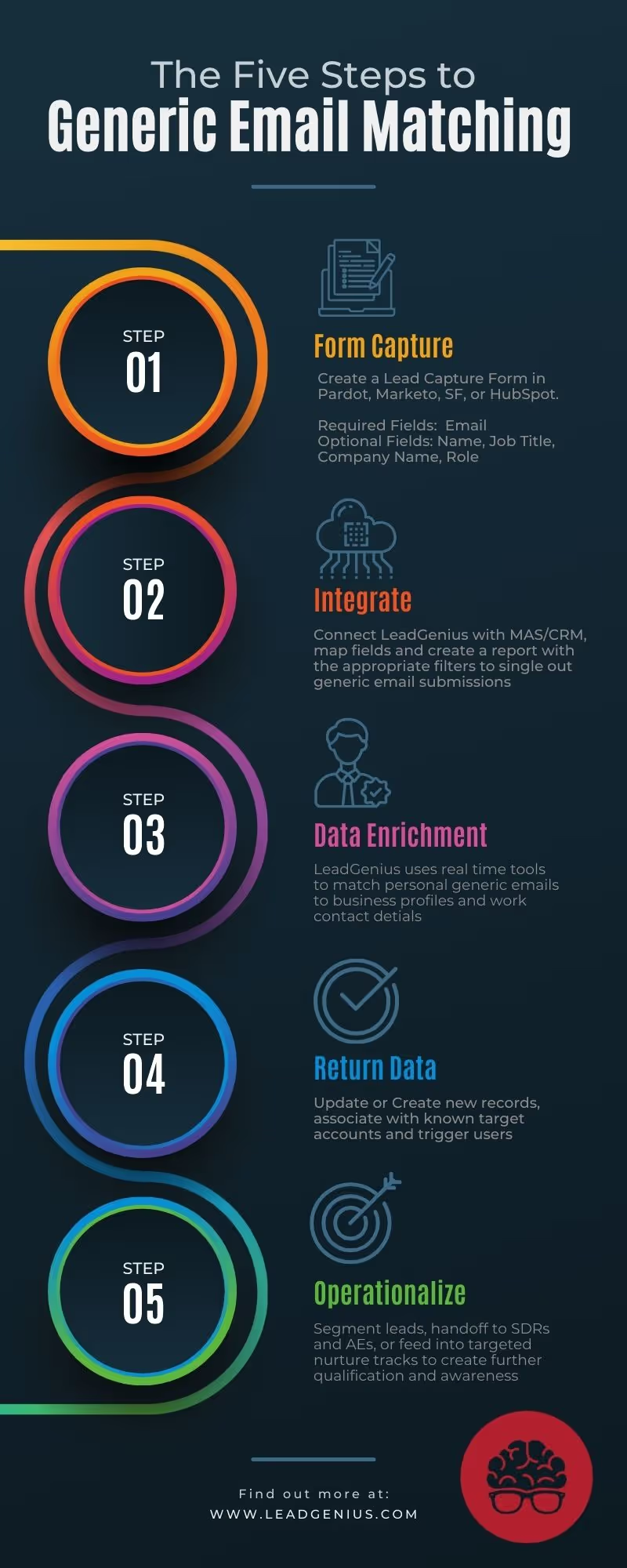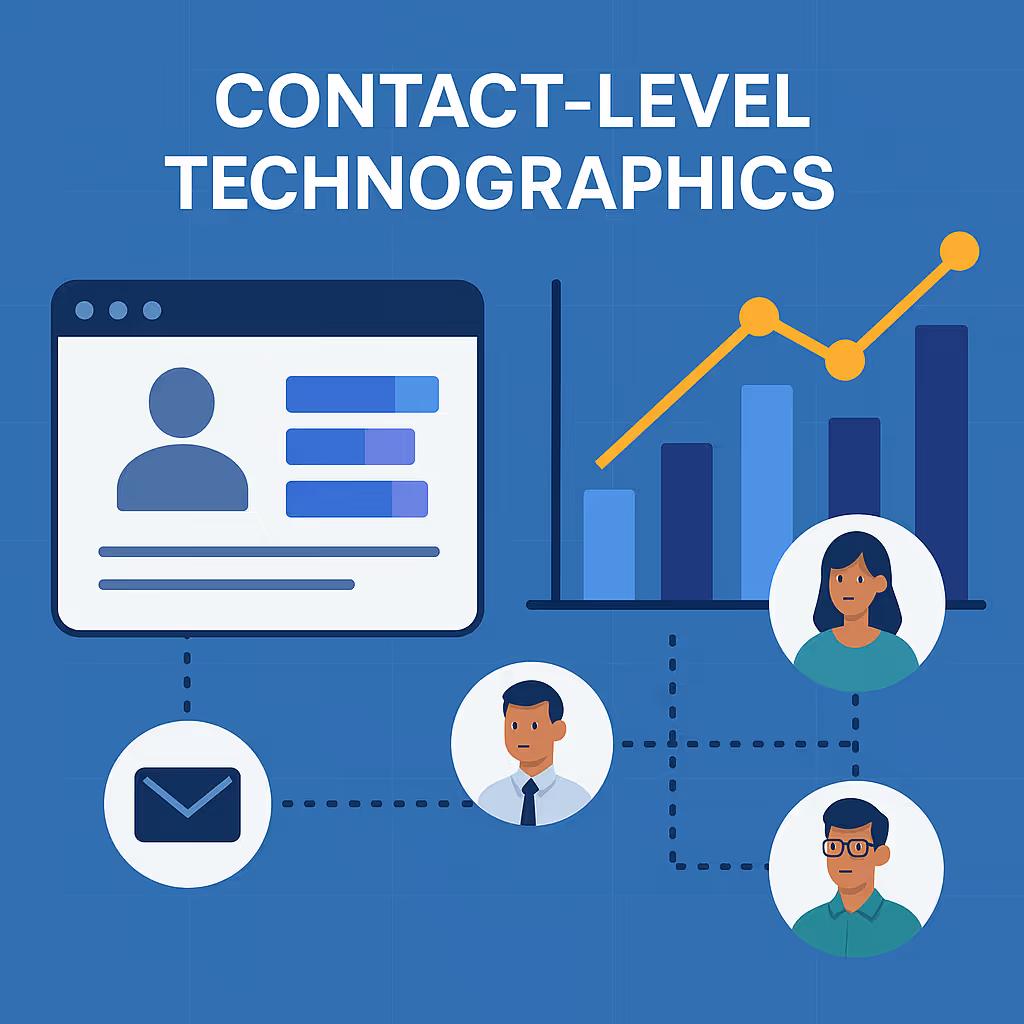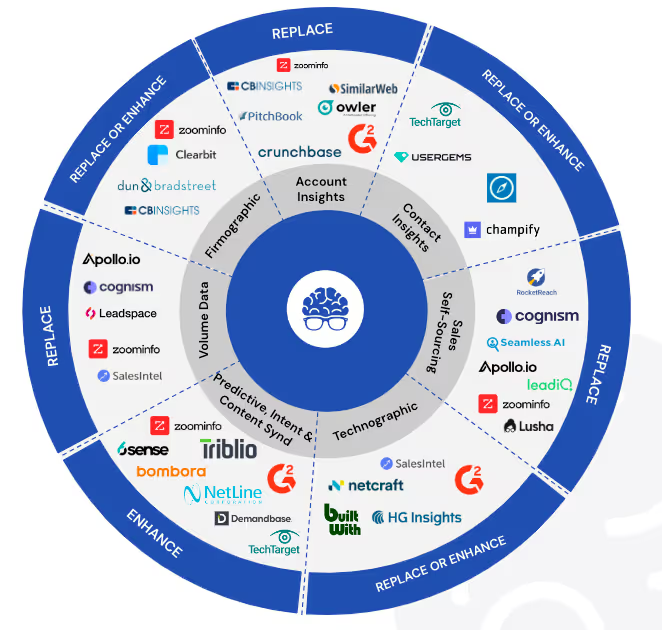In the world of B2B marketing and sales, data quality is paramount. Capturing generic emails (e.g., Gmail, Yahoo) through lead forms is a common practice, but these addresses often lack the detailed business information needed to drive effective marketing campaigns and sales efforts. This is where LeadGenius comes in. By integrating LeadGenius with marketing automation platforms like Pardot, Marketo, or HubSpot, businesses can enrich these generic emails with valuable business profiles, achieving match rates of 60% or higher. Here’s how you can set up this process and start reaping the benefits.
Creating a Workflow for Enriching Generic Emails
Enriching generic emails using LeadGenius, integrated with marketing automation platforms like Pardot, Marketo, or HubSpot, involves several key steps. Let's dive into the detailed workflow:
Step 1: Set Up Form Capture
Create a Lead Capture Form:
First, you need to create a form in your chosen marketing automation platform (Pardot, Marketo, or HubSpot) to capture lead information. This form should include fields such as Name, Generic Email, and optional fields like Department, Job Title, and Company Name.
Form Fields:
Ensure your form collects all necessary details that can help in the enrichment process. Besides the generic email, additional fields like job title and company name can significantly enhance the matching accuracy.
Step 2: Integrate Form with LeadGenius
API Configuration:
Configure the API integration between your marketing automation platform and LeadGenius. This step involves setting up the necessary credentials and permissions to allow seamless data flow.
Report Trigger or Webhook Creation:
Instead of relying solely on webhooks, set up a specific report within your marketing platform (Salesforce, Marketo, HubSpot, or Pardot) that captures leads with generic emails. This report will serve as the trigger for the enrichment process.
Step 3: Data Enrichment Process
Report Trigger or Webhook:
When the form is submitted, the leads with generic emails are captured by the specific report in your marketing platform. Alternatively, a webhook can be used to send the captured data to LeadGenius.
LeadGenius Processing:
- Email Matching: LeadGenius uses its proprietary algorithms to match the generic email to a business profile.
- Data Enrichment: LeadGenius enriches the record with additional business details such as:
- Work Email
- Company Name
- Company Size
- Industry
- Job Title
- Firmographics
- Linkedin Profiles or other social handles
Step 4: Data Return and Integration
Data Return:
Once the data is enriched, LeadGenius sends it back to your marketing automation platform.
Data Mapping:
Map the returned data fields from LeadGenius to the corresponding fields in your marketing platform’s contact or lead database. This ensures the enriched data is accurately reflected in your system.
Step 5: Workflow Automation
Automation Rules:
Set up automation rules in your marketing platform to update or create new records with the enriched data. This step is crucial for maintaining data consistency and ensuring all new leads are enriched upon entry.
Segmentation and Nurturing:
Use the enriched data to segment leads and tailor your marketing campaigns. By having detailed business profiles, you can create more targeted and personalized nurturing workflows, increasing engagement and conversion rates.
Example Workflow
- Lead Capture: A user fills out a form on your website using a generic email.
- Report Trigger: The form submission is captured by a specific report in your marketing platform.
- LeadGenius Enrichment: LeadGenius receives the generic email and enriches it with a business profile.
- Data Return: Enriched data is sent back to your marketing platform.
- Data Mapping and Update: The marketing platform updates the lead record with the new data.
- Automated Campaigns: The enriched lead is placed into appropriate segments and nurturing workflows.
Implementation Steps by Platform
In Pardot:
- Form Creation: Create a form in Pardot to capture leads.
- Integration Setup: Use Pardot's automation rules and connectors to send data to LeadGenius.
- Report Trigger: Set up a report in Pardot to capture generic email leads and trigger the enrichment process.
- Data Mapping: Configure Pardot to receive enriched data and update lead records.
In Marketo:
- Form Design: Design a form in Marketo to collect lead information.
- Webhook Configuration: Set up a webhook in Marketo to send form data to LeadGenius.
- Report Trigger: Create a report in Marketo to capture generic email leads and trigger the enrichment process.
- Enrichment Processing: Receive enriched data and map it to Marketo fields.
- Smart Campaigns: Use Smart Campaigns to automate follow-up actions based on the enriched data.
In HubSpot:
- Form Setup: Create a HubSpot form to gather lead information.
- Workflow Creation: Set up a workflow in HubSpot to trigger on form submission and send data to LeadGenius.
- Report Trigger: Create a report in HubSpot to capture generic email leads and trigger the enrichment process.
- Data Synchronization: Map the enriched data back to HubSpot lead records.
- Automated Actions: Use HubSpot's automation tools to segment and nurture the enriched leads.
Achieving 60%+ Match Rates
Many businesses have successfully implemented this workflow, achieving match rates of 60% or higher. This success is due to the robust matching algorithms and comprehensive data enrichment capabilities of LeadGenius. By leveraging these tools, businesses can transform generic email leads into valuable, actionable data, driving more effective marketing campaigns and improving sales outcomes.
Conclusion
Integrating LeadGenius with your marketing automation platform to enrich generic emails is a powerful way to enhance your lead data quality. With detailed business profiles, you can better segment your leads, personalize your marketing efforts, and ultimately drive higher engagement and conversion rates. Implementing this workflow might seem complex, but the payoff in enriched data and improved campaign performance makes it well worth the effort.




